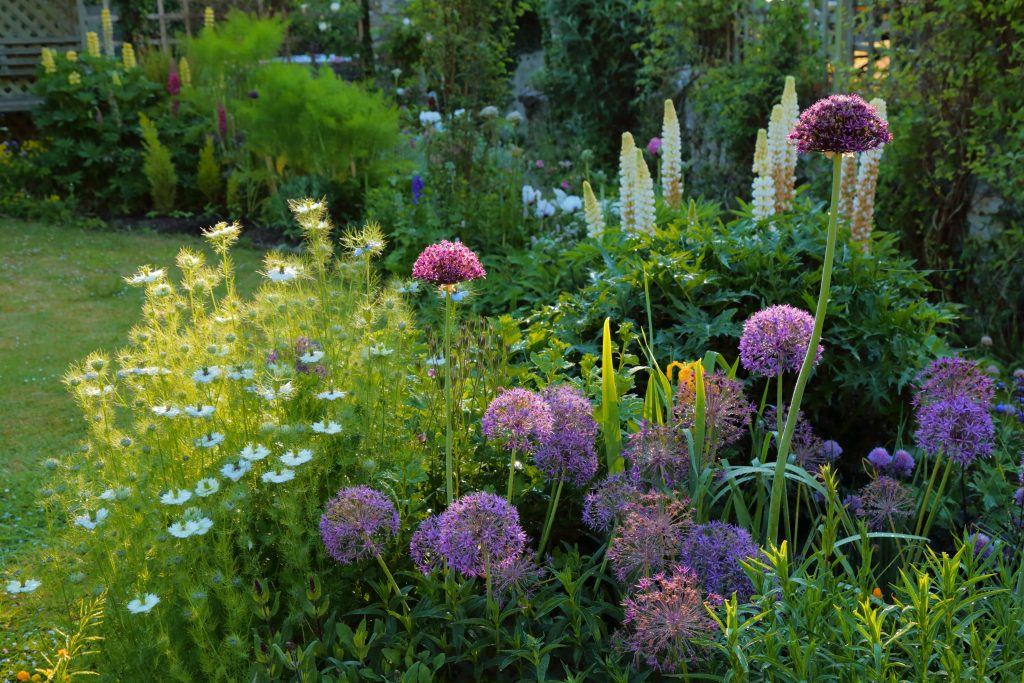English Cottage Gardens – An Exploration Through History and Design

Known for its informal design, lush plants, and timeless appeal, the English cottage garden remains a beloved choice – either to live or take inspiration from. From climbing roses to quaint picket fences, this style offers an inviting, relaxed aesthetic that continues to flourish in modern gardens, proving that classic beauty never fades.
A Brief History of English Cottage Gardens

English cottage gardens have their roots in the simple, rural life of 16th-century England. Originally, these gardens were modest plots surrounding small cottages, primarily serving as a means of sustenance. Homeowners cultivated vegetables, herbs, and fruit trees, often planting them alongside hardy flowers that could withstand the British weather.
The plants were chosen not for decoration but for their utility, providing food, medicine, and even pest control. These early cottage gardens featured plants like rosemary, thyme, and marigolds, which were easy to grow and served multiple purposes. Flowers such as daisies and primroses often bordered the vegetable patches, adding a splash of colour to the garden while attracting bees and other pollinators.
How English Cottages Were Influenced Over Time

By the 19th century, as society shifted, so did the purpose and style of the cottage garden. With the rise of the Arts and Crafts movement, there was a growing desire to return to natural beauty and traditional craftsmanship, in response to the rapid industrialisation of the era. This movement influenced garden design, transforming the cottage garden from a utilitarian space into something far more decorative and romantic.
Influenced by the likes of William Morris and Gertrude Jekyll, the new vision for cottage gardens embraced nature's unruliness, allowing flowers to spill over pathways and plants to grow freely. Climbing roses and shrub roses became iconic features, trailing over trellises and cottage walls, while borders were filled with vibrant hardy geraniums, lavender, and foxgloves.
The Key Elements of the Cottage Garden Style

At the heart of every cottage garden is a vibrant, unstructured planting scheme that embraces nature’s beauty. The informal design is key, allowing plants to flourish freely without strict boundaries.
Key among these are climbing roses and shrub roses, which have become synonymous with cottage style. These classic plants cascade over trellises, walls, and arches, creating a lush, romantic atmosphere. Alongside them, hardy geraniums provide a burst of colour while thriving in full sun and well-drained soil. Other cottage garden favourites like foxgloves, lavender, and hollyhocks add vertical interest, creating a tapestry of textures and hues.
Quintessentially English Design & Layout
A cottage garden’s structure is equally important in evoking that quintessentially English feel. Picket fences, typically painted white, form the perfect boundary for this garden style, offering a welcoming touch while keeping things informal. Winding paths made from brick, stone, or gravel help guide visitors through the garden, while wood chips or mulch provide an attractive, natural ground cover that helps retain moisture and suppress weeds.
Meandering paths allow the garden to feel larger, even in smaller spaces – inviting exploration.
Making It Work in Contemporary Gardens
While the traditional cottage garden is associated with rural settings, modern gardeners have adapted the style to suit urban spaces. Small courtyards or city gardens can still capture the essence of the cottage style by incorporating a selection of cottage garden plants that thrive in pots or raised beds. In these settings, vertical planting becomes essential, with climbing roses or fashioned roses trailing over walls and fences.
Contemporary cottage gardens often lean towards sustainability, with a focus on natural materials and garden designs that benefit wildlife. This includes the use of reclaimed wood for fencing, organic mulch-like wood chips, and rainwater harvesting for irrigation.
Creating Your Perfect Cottage Garden
1. Choose a Variety of Plants
Designing your perfect cottage garden starts with selecting a wide variety of plants that will bring your outdoor space to life throughout the year. Focus on choosing plants that bloom in early spring, such as daffodils, tulips, and snowdrops, which will provide the first burst of colour. As the seasons progress, fill your garden with climbing roses, shrub roses, and hardy geraniums, ensuring your garden is continually in bloom.
2. Say No to Neatness
To achieve the relaxed, natural look of a classic cottage garden, mix flowers, vegetables, and herbs within your borders. This combination creates visual interest and serves a practical purpose. Herbs like rosemary, thyme, and lavender add fragrance while attracting bees and other pollinators, and vegetables such as kale, beans, or lettuce can thrive in between flowering plants.
3. Give Your Plants What They Need
When planting, consider the needs of your plants. Many cottage garden favourites like roses and geraniums thrive in full sun, so choose spots where they will receive plenty of light throughout the day. For shady areas, plants like foxgloves or ferns can add depth and texture. Ensure that the soil is well-drained to keep your plants healthy, especially after the frequent British rain.
4. Maintain the Wild Aesthetic
Although the cottage garden style is informal, it still requires some upkeep. Prune climbing roses and remove dead flowers to encourage new growth. The key is to keep the garden looking natural without letting it become overgrown. Maintain pathways and borders, but resist the urge to over-manicure – part of the charm is the slightly wild, untamed look that makes these gardens feel welcoming and lived-in.
Traditional Cottage Gardens in the Modern Day

As we touched on above, there’s a growing interest in natural, eco-friendly gardening in the UK, with many homeowners seeking to create beautiful outdoor spaces that are as kind to the environment as they are visually appealing. Sustainable materials like wood chips for ground cover are increasingly popular, providing a natural, organic mulch that retains moisture and reduces waste. Similarly, rainwater collection systems and composting are being integrated into cottage garden designs.
Modern technology also plays a role in contemporary cottage garden design. From garden design apps to smart irrigation systems, homeowners can now plan their layouts and monitor plant health more easily. However, there is also a return to more traditional methods, such as the planting of fashioned roses and using hand tools for maintenance, reflecting a desire for authenticity and simplicity in the garden.
Embrace the Magic of Cottage Gardening

Whether you’re growing climbing roses, tending to a vegetable plot, or attracting bees and other pollinators, the cottage garden style allows you and your family to enjoy a harmonious connection with nature, and by balancing tradition with contemporary trends, your outdoor space will continue to flourish for years to come.




